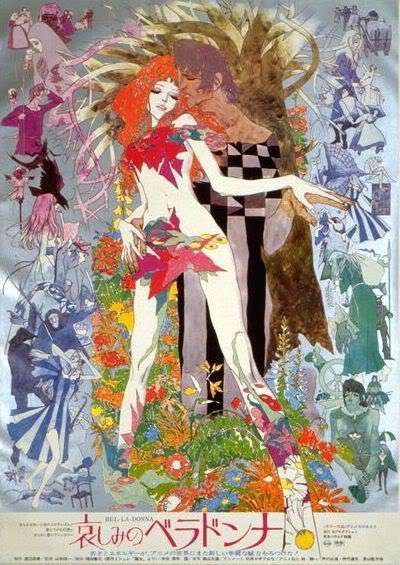Kanashimi no Belladonna

Kanashimi no Belladonna (literally Belladonna of Sadness, also known as The Tragedy of Belladonna) is an avant-garde anime film made in 1973 and Inspired By Jules Michele's non-fiction book Satanism and Witchcraft (or La Sorciere).
The story follows the peasant woman Jeanne, who has just been Happily Married to Jean when the village nobility demands an absurdly high marriage tax. The couple can't pay, so the baron sees fit to have his way with the bride.
When she returns home, Jeanne is seduced by a demon and finds herself gradually turning to witchcraft to find empowerment and freedom. At first, she and her husband are prosperous, but as famine, war, and the bubonic plague strike the rest of the village, suspicion grows and Jeanne is eventually cast out of the village. She wins the villagers over when she offers a miracle cure for the plague, but then the nobility catches wind of her power...
Although the film was initially a commercial failure, it has gained some recognition in anime circles for its experimental animation, which is full of beautifully painted still images, Art Nouveau inspired imagery, and heavily stylized depictions of sex. The film also inspired Kunihiko Ikuhara to work in anime, and its visual and thematic influences can be seen in Revolutionary Girl Utena.
- Aristocrats Are Evil: The baron and baroness.
- Clothing Damage: When Jeanne flees from the village, her cloak and tunic are gradually ripped apart until she reaches the wildnerness completely nude.
- Crucified Hero Shot: Jeanne gets executed on a burning cross-shaped stake.
- Deadly Decadent Court
- Deal with the Devil
- Deranged Animation: The sex scenes, especially Jeanne's rape [1], are packed with surreal and often disturbing imagery.
- Downer Ending
- Happily Married: All of five minutes in the film before things go downhill.
- Mind Rape: Jeanne's encounter with the fully-grown demon in the wilderness might qualify.
- Mind Screw
- No Export for You: There were DVD releases in Japan and Europe, with no official release with English subtitles.
- Rape as Drama: In a very symbolic but very graphic scene.
- The Seventies: Jeanne and Jean's full hair, the trippy images derived from Art Nouveau, and the quirky folk-rock soundtrack make it pretty obvious that this was made in the early '70s.
- Visual Innuendo: Despite the numerous explicit sex scenes and a distinct aversion of Barbie Doll Anatomy, the animation uses free forms and contours to convey the eroticism of these scenes.
- ↑ which begins with a white silhouette of her body being torn in half through the crotch